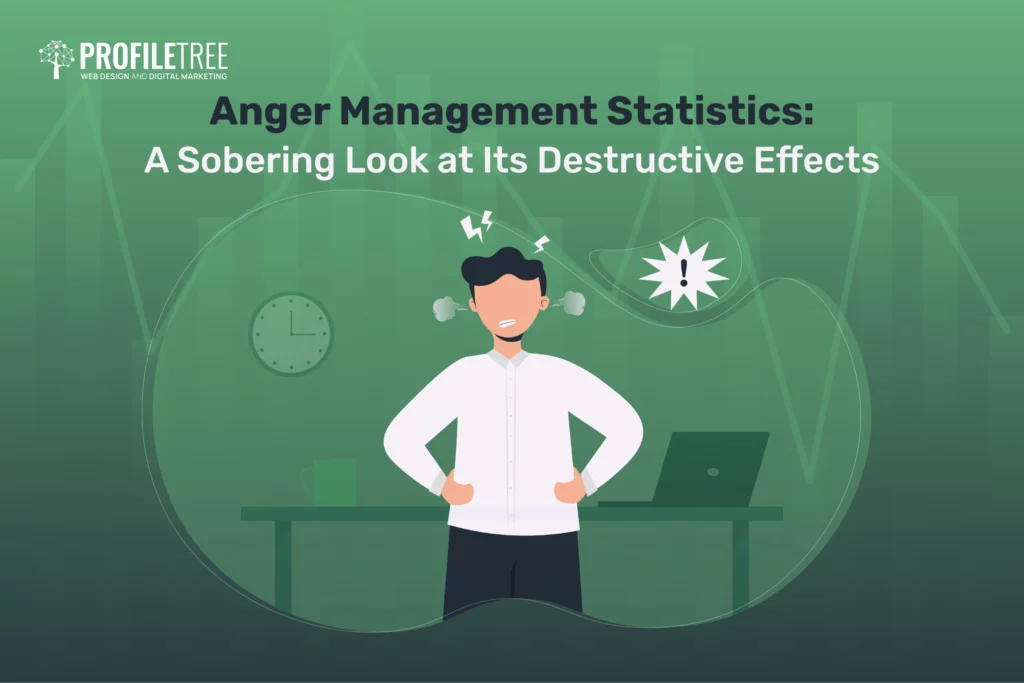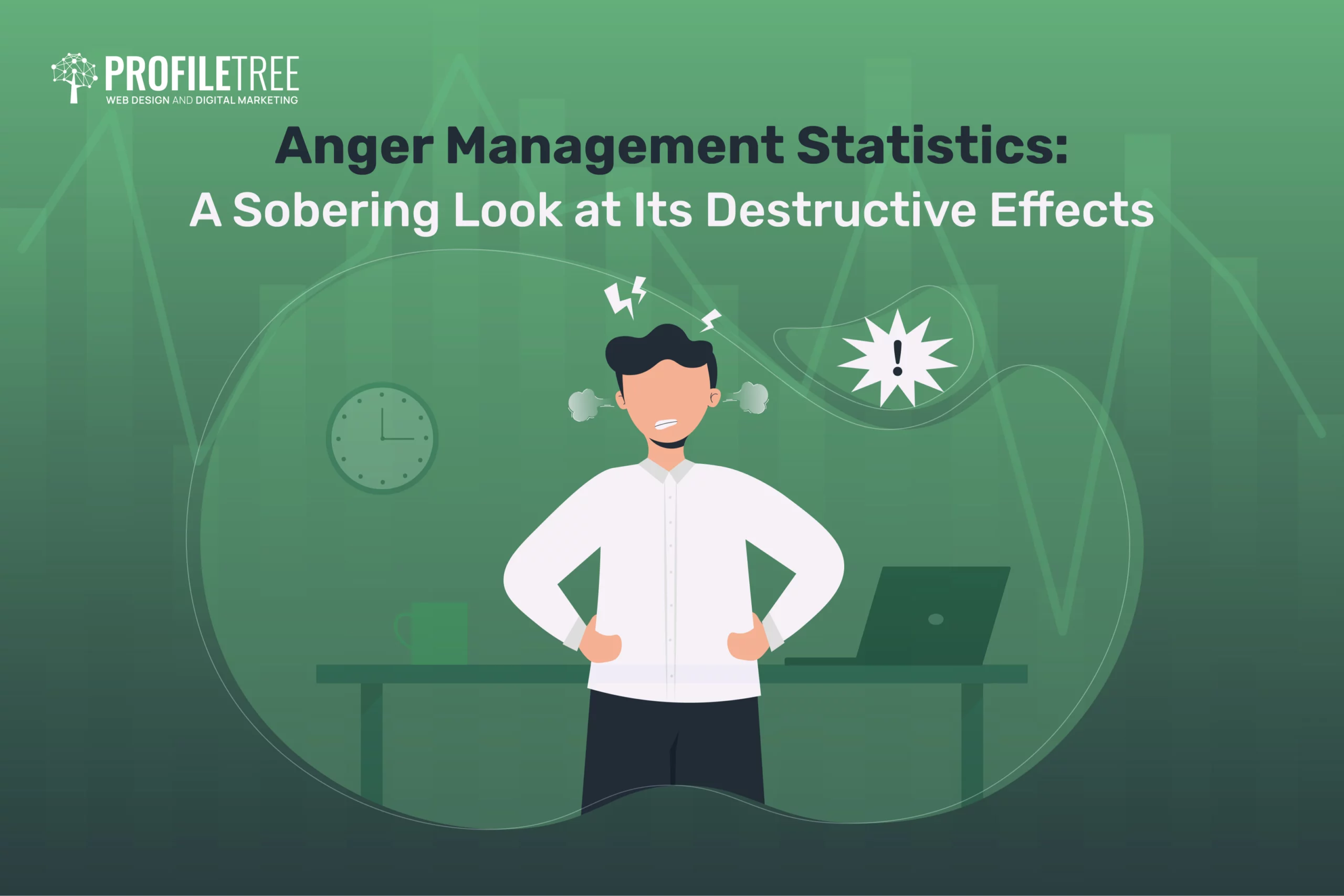While anger is a natural human feeling, it can become destructive when left unchecked. This powerful emotion has an incredible rippling impact inward, affecting our mental and physical health, relationships and even workplace productivity. It can also lead to destructive societal effects when we don’t take the necessary steps to handle it better. This Anger Management Statistics article will explain the sobering picture of the consequences of uncontrolled anger.

Anger Management Statistics and its Effect on General Life
Anger can affect us, our immediate circle and society eventually. These effects necessitate the vigilant and decisive management of anger. While venting steam is healthy to rid you of negative emotions, it’s vital to blow off this steam in a healthy manner that doesn’t cause you or anyone else harm. How can anger affect our lives?
Personal Impact
Anger management statistics showed that this volatile emotion can significantly impact people. In line with this, 12% of the population struggles to control their anger. In comparison, 28% expressed their worry about the intensity of their anger, which indicates a high level of concern and self-awareness about anger’s potential harm. Moreover, 20% of people admitted losing relationships due to anger issues, highlighting its devastating impact on our personal lives.
Professional Impact
Unfortunately, anger is also present in the office, termed “Office rage. A staggering 65% of office workers experience office rage, which is an alarming percentage. Forty-five per cent of employees lose their temper regularly at work, while 53% admitted to being bullied at work. These high numbers showcase how anger can manifest in various forms at the workplace, even in passive-aggressive behaviour.
Societal Impact
If we see anger’s impact on our personal and work lives, it’s a given these effects will reach our society as well. Anger management statistics revealed that 80% of drivers have witnessed road rage, which is a serious threat to public safety. Furthermore, 25% of drivers admitted to committing road rage, underlining the increasing number of individuals engaging in this dangerous behaviour. According to anger management statistics, 64% of people believe society is becoming angrier, which expresses a growing worry about the rising levels of anger in our communities.

Mental Health
Chronic anger is linked to anxiety, depression, and higher risks of heart disease and stroke, demonstrating the significant toll it takes on our mental and physical well-being. More than 40% of those with anxiety disorders reported anger problems, while more than 30% of people with depression suffer from frequent anger outbursts, as revealed by anger management statistics.
Anger Management Statistics from the Teacher Support Line
What we mean by anger management statistics from the teacher support line is the data collected by hotlines or organisations specifically dedicated to supporting teachers facing anger-related challenges. These statistics demonstrate the prevalence and impact of anger issues within the teaching profession and instil worry inside parents for their children who might suffer from a teacher’s anger outburst. Here’s a breakdown of the teacher support line’s most prevalent anger management statistics.
- Twenty per cent of teachers seek help managing their anger, which highlights the awareness among educators of the need to address their anger issues. They acknowledge anger’s potential effect on their interactions with students and colleagues.
- Forty-five per cent of teachers witnessed violence in the classroom. Unfortunately, this high number emphasises the teachers’ exposure to aggressive behaviour from students, which can be a significant source of stress and anger triggers.
- Thirty-two per cent of teachers worried about the anger of their students. This statistic highlights teachers’ concern about managing student anger within the classroom and its possible impact on the learning environment and their well-being.
We must stress the importance of teacher support lines and their crucial role in providing resources and guidance to educators dealing with anger management, creating a more positive and productive educational environment for everyone.
Anger Management Statistics in the Office

Anger in the workplace, unfortunately, is more common than you might think. We briefly mentioned several anger management statistics in the workplace; here’s a clearer picture of its prevalence and destructive impact on the workforce.
Widespread Occurrence
According to anger management statistics, over 60% of office workers have experienced uncontrolled anger outbursts directed at their colleagues, customers or even helpless equipment. Forty-five per cent of employees have anger management problems as they continue to lose their temper at work. Finally, anger management statistics showed us that more than 50% of employees admitted that their colleagues and superiors had bullied them at work.
How Anger Affects Employees
Anger affects its victims in the workplace, as in every place in life, and, unfortunately, some of these negative effects can be crippling, as stated by anger management statistics. Angry employees suffer from decreased productivity as they are often less focused or efficient, impacting office workflow. Uncontrolled anger can create a toxic work environment, leading to employee dissatisfaction and increased resignation rates.
We can say that anger leads to damaged work relationships due to the strain it puts on colleagues, clients and superiors, hindering collaboration and communication. Sadly, anger-related issues such as bullying decreased productivity, and legal issues can cost companies significantly.
What Triggers Office Rage?
Many elements in the workplace can trigger office rage, such as tight deadlines and workload pressure, creating a stressful work environment. If there are any workplace conflicts or personality clashes, anger management statistics clarify that they can be a major source of frustration, which leads to angry bursts. Anger management statistics also add that unclear or miscommunication with one’s superiors and feeling undervalued can fuel anger.
Can Companies Help in Anger Management to Control Office Rage?
Uncontrolled anger in the workplace is detrimental to individuals, teams and companies. Companies can help significantly in anger management by raising awareness and being proactive.
- Companies can provide anger management programs to equip their employees with the proper tools for managing anger and resolving conflict in a constructive manner.
- Through employee assistance programs, companies give their employees access to mental health resources, which can help individuals address underlying causes of anger and develop coping mechanisms.
- Companies can foster open communication, respect and stress management initiatives to create a more positive and anger-preventive environment.
Anger Management Statistics Related to Communication Tools
Although advanced communication tools have allowed us to communicate with people from the other side of the planet, anger management statistics proved that this technological advancement demonstrates the surprising link between our chosen communication channels and anger expression. Regardless of the communication tool, uncontrolled anger can damage relationships. For example, angry emails or phone calls can create lasting negativity and misunderstandings.
Phone as an Anger Magnet
Anger management statistics state that 65% of angry outbursts occur on the phone. The probable reason behind this alarming anger management statistic is the lack of visual cues and the feeling of anonymity, which leads to uninhibited aggression. To further affirm this fact, 22% of people report feeling angrier during phone calls than face-to-face interactions. This highlights that the disembodied nature of phone conversations can make it easier to lose control.

Written Rage
Anger management statistics tell us that 26% of angry outbursts happen through written communication tools, such as emails, texts and online chats. Although these types of communication tools fall under instant messaging, the delayed response and potential for misinterpretation can fuel frustration. On another note, 17% of people added they find it easier to express their anger in writing than in speaking, but this can lead to passive-aggressive behaviour or overly critical language.
Face-to-Face Fury
The basic tool of communication is face-to-face communication. Anger management statistics reveal that only 9% of angry outbursts happen face-to-face. They attributed this number to potential greater awareness of social cues and possible consequences in direct interactions. However, face-to-face anger can be more intense and have immediate negative consequences for both parties involved.
Anger Management Statistics about Behavioural Rage
Behavioural rage is a term encompassing extreme and uncontrolled anger often accompanied by destructive behaviour. This destructive behaviour can manifest in various ways and affects our lives accordingly. The following anger management statistics bring us a variety of instances where people’s behaviour flipped into anger.
Behavioural Rage Prevalence
Believe it or not, many people feel frustrated by technology. According to anger management statistics, 50% of people feel rage towards technological issues, such as computer crashes. Another anger management statistic shows that 1 in 20 people have admitted to having a physical altercation with a neighbour, which highlights how seemingly trivial disputes can escalate into aggressive behaviour. In the health sector, 27% of nurses reported experiencing physical assault at work, which reveals the vulnerability of certain professions to rage-fueled violence.
Behavioural Rage Triggers
Different reasons can cause behavioural rage, such as feeling unheard or disrespected when individuals feel their needs or opinions are disregarded. In situations where individuals feel helpless or powerless, their loss of control or power can trigger overwhelming anger. Chronic stress and frustration build resentment, creating a ripe breeding ground for rage.
Behavioural Rage Consequences
It’s not surprising that behavioural rage can damage relationships; rageful outbursts can sever personal and professional ties and leave lasting scars. Moreover, physical aggression can lead to legal consequences depending on the severity of the actions. Lastly, chronic anger takes a toll on mental health and can contribute to physical health problems such as high blood pressure.
Addressing Behavioural Rage
Addressing behavioural rage is similar to addressing all types of rage. Anger management therapy is one of the best methods to seek, where you learn coping mechanisms and how to identify triggers, and this knowledge can equip people with tools to manage rage effectively. Seeking stress management techniques such as meditation, yoga and exercise can help individuals regulate their emotions and avoid reaching boiling points. Effective and healthy communication skills can prevent escalation, where people express their needs and frustrations assertively rather than using aggression.
Anger Management Statistics: The Effect of Anger on Mental Health
Anger, though a natural human emotion, can wreak havoc on our mental well-being when left unchecked. The following anger management statistics show us the detrimental impact anger can have on our mental health, relationships and overall well-being. We must stress that anger is manageable.
Anger Management Statistics: Mental Health Connections
Anger management statistics confirm the link between anger and anxiety as they reveal that 45% of people suffering from anxiety disorders report significant anger problems. Thirty-two per cent of people struggling with depression suffer frequent anger outbursts, in this case, anger can be a symptom or contributor to the depression. Sadly, 20% of people with chronic anger report suicidal thoughts, which sheds light on the staggering connection between uncontrolled anger and self-harm ideation.
Anger Management Statistics: Physical Manifestations
According to anger management statistics, anger can greatly affect our physical health. Eighty-five per cent of people with uncontrolled anger suffer from physical symptoms like headaches, fatigue and muscle tension during angry episodes. This statistic demonstrates the strong mind-body connection where anger affects both mental and physical health. Anger management statistics tell us that 16% of people with chronic anger have high blood pressure or heart disease, possibly due to the increased stress and physiological arousal associated with frequent anger outbursts.
Anger Management Statistics: The Impact on Quality of Life
It’s natural that if anger affects our mental and physical health, its effect will extend to the quality of our lives. Unfortunately, 20% of people have lost relationships due to anger issues. Fifty-seven per cent of people with anger problems report decreased job satisfaction and productivity.
Anger Management Statistics: The Path to Healing
Despite anger’s lethal effect on the quality of our lives, only 13% of people who suffer from anger problems seek professional help. This number shows us the gap between the need for support and the actual utilisation of resources. Statistics follow up with this number, where 58% of people wouldn’t know where to get help. Eighty-four per cent of people agree that those struggling with anger should seek help, which indicates increased awareness of addressing this issue.
What to Do if You Can’t Control Your Anger
Anger is a natural emotion that doesn’t have to control you. By understanding its impact and learning healthy coping mechanisms, you can build healthier relationships and live a calmer, more fulfilling life. Here are some helpful steps you can take if you’re struggling to control your anger.
Recognize the Warning Signs
Anger manifests itself emotionally, physically and behaviourally. Emotional signs can be irritability, frustration, impatience and feeling like you’re about to explode. Physical signs include increased heart rate, sweating, muscle tension, clenched fists or grinding teeth. Behavioural signs of anger include yelling, arguing, slamming doors, throwing objects and becoming passive-aggressive.
Take a Time Out
The concept of Time Out is a lifesaver. You can remove yourself from the irritating situation by taking a few deep breaths, walking or stepping outside. Relaxation techniques, like yoga, deep breathing exercises, progressive muscle relaxation and meditation, can significantly help you manage your emotions. Distract yourself by engaging in calming activities such as hiking, reading, listening to music or spending time in calming nature. Exercise is also a great way to relieve stress and improve your mood.
Communicate Assertively
Proper communication is vital in avoiding anger outbursts. Make sure to express your feelings calmly and respectfully. Avoid blaming others when expressing yourself; use “I feel frustrated when..” instead of “You always…”, which will help you relinquish negative feelings. You need to focus on problem-solving, so work together to find a solution that works for both parties. If you feel emotions are running high in the conversation, suggest taking a break to take deep breaths and calm down. You can also consider alternative means of communication methods if you feel that phone calls trigger your anger.
Lifestyle Changes
Numerous lifestyle changes can help you better control your anger. Begin by identifying your triggers and what situations or people tend to make you angry to develop proper coping mechanisms. Challenge your negative thoughts by crowding out your angry or negative thoughts with more realistic and positive ones. A healthy diet helps regulate blood sugar and is a great mood enhancer, making you less likely to get angry. Remember, when you’re well-rested, you’re better able to cope with stress and anger. So, get enough sleep!
You’re not alone in this; many people struggle with anger, and there are numerous effective ways to manage it. If you don’t know where to start, seek professional help, which will also assist you in better communicating your need for help to others. You can learn to manage your anger and live a happier, healthier life with time and effort.


